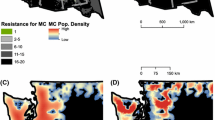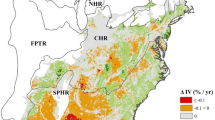The ability of trees to migrate in response to climatic warming was simulated under various conditions of habitat availability. The model uses Holocene tree migration rates to approximate maximum migration rates in a forested landscape. Habitat availability and local population size was varied systematically under two dispersal and colonization models. These dispersal models varied in the likelihood of long-distance dispersal events. The first model used a negative exponential function that severely limited the probability of long-distance dispersal. The results of this model indicate that migration rate could decline an order of magnitude where the habitat availability is reduced from 80 to 20% of the matrix. The second model, using an inverse power function, carried a higher probability of long-distance dispersal events. The results from this model predict relatively small declines in migration rates when habitat availability is reduced to 50% of the simulation matrix. Below 50% habitat availability, mean migration rate was similar to the negative exponential model. These results predict a failure of many trees to respond to future climatic change through range expansion.
Similar content being viewed by others
References
Alverson, W.S., Waller, D.M. and Solheim, S.L. (1988). Forests too deer: edge effects in northern Wisconsin. Cons. Biol. 2, 348–58.
Anderson, R.C. and Loucks, O.L. (1979) White-tail deer (Odocoileus virginianus) influence on structure and composition of Tsuga canadensis forests. J. Appl. Ecol. 16, 885–61.
Calcote, R.R. (1986) Hemlock in Minnesota: 1200 years as a rare species. MS thesis. University of Minnesota, Minneapolis, MN.
Carter, R.N. and Prince, S.D. (1988) Epidemic models used to explain biogeographical distribution limits. Nature 293, 644–5.
Carter, R.N. and Prince, S.D. (1988) Distribution limits from a demographic viewpoint. In Plant Population Ecology: the 28th symposium of the British Ecological Society, Sussex 1988 (A.J., Davy, M.J., Hutchings and A.R., Watkinson, eds) pp. 165–84. Oxford: Blackwell Scientific.
Curtis, T.J. (1956) The modification of mid-latitude grasslands and forests by man. In Man's Role in Changing the Face of the Earth (W.L., Thomas, ed.) pp. 721–36. Chicago: University of Chicago Press.
Davis, M.B. (1981) Quaternary history and the stability of forest communities. In Forest Succession (D.C., West and H.H., Shugart, eds) pp. 132–53, New York: Springer-Verlag.
Davis, M.B. (1984) Climatic instability, time lags, and community disequilibrium. In Community Ecology (J., Diamond and T.J., Case, eds) pp. 269–84. New York: Harper and Row.
Davis, M.B. (1989) Lags in vegetation response to greenhouse warming. Clim. Change. 15, 75–82.
Davis, M.B., Woods, K.D., Webb, S.L. and Futyma, R.P. (1986) Dispersal versus climate: expansion of Fagus and Tsuga into the Upper Great Lakes region. Vegetatio 67, 93–103.
Davis, M.B. and Zabinski, C. (1992) Changes in geographical range resulting from greenhouse warming: effects on biodiversity in forests. In Consequences of Greenhouse Warming to Biodiversity (R.L., Peters, ed.) pp. 297–308. Yale: Yale University Press.
Dunn, C.P., Sharpe, D.M., Guntenspergen, G.R., Stearns, F. and Young, Z. (1991) Methods for analyzing temporal changes in landscape pattern. In Quantitative Methods in Landscape Ecology (M.G., Turner and R.H., Gardner, eds) pp. 173–98 Ecological Studies #82. New York: Springer-Verlag.
Fitt, B.D.L. and McCartney, H.A. (1986) Spore dispersal in relation to epidemic models. In Plant Disease Epidemiology Vol. 1 (K.J., Leonard and W.E., Fry, eds) pp. 311–45. New York: Macmillan.
Frampton, V.L., Linn, M.B. and Hansing, E.D. (1942) The spread of virus diseases of the yellow type under field conditions. Phytopath. 32, 799–808.
Graham, R.W. and Grimm, E.C. (1990) Effects of global climate change on the patterns of terrestrial biological communities. Trends Ecol. Evol. 5, 289–92.
Gregory, P.H. (1968) Interpreting plant disease dispersal gradients. Ann. Rev. Phytopath. 6, 189–212.
Harper, J.L. (1977) Population Biology of Plants. London: Academic Press.
Huntley, B. (1989) European post-glacial vegetation history: a new perspective. In Proceedings of the XIX International Ornithological Congress Vol. 1, (H., Ouellet, ed.) pp. 1060–77. Ottawa: University of Ottawa Press.
Huntley, B. (1991) How plants respond to climate change: migration rates, individualism and the consequences for plant communities. Ann. Botany 67 (supp), 15–22.
Huntley, B. and Birks, H.J.B. (1983) An Atlas of Past and Present Pollen Maps for Europe: 0–13,000 Years Ago. Cambridge: Cambridge University Press.
Iverson, L.R., Rolfe, G.L., Jacob, T.J., Hodgins, A.S. and Jeffords, M.R. (1991) Forests of Illinois. Illinois Council on Forestry Development, Urbana, and Illinois Natural History Survey, Champaign.
Johnson, W.C. (1988) Estimating dispersability of Acer, Fraxinus and Tilia in fragmented landscapes from patterns of seedling establishment. Land. Ecol. 1, 175–87.
Johnson, W.C., Sharpe, D.M., DeAngelis, D.L., Fields, D.E. and Olson, R.J. (1981) Modeling seed dispersal and forest island dynamics. In Forest Island Dynamics in Man-dominated Landscapes (R.L., Burgess and D.M., Sharpe, eds) pp. 287–310. Ecological Studies #41. New York: Springer-Verlag.
Little Jr, E.L. (1971) Atlas of United States Trees, Volume 1. Conifers and Important Hardwoods. Washington, DC: USDA Misc Publ. No. 1146.
Loehle, C. (1987) Tree life history strategies: the role of defenses. Can. J. For. Res. 18, 209–22.
McCartney, H.A. and Bainbridge, A. (1984) Deposition gradients near to a point source in a barley crop. Phytopath Zeits 109, 219–36.
Melillo, J.M., Callaghan, T.V., Woodward, F.I., Salati, E. and Sinha, S.K. (1990) Effects on ecosystems. In Climate Change: the IPCC Scientific Assessment (J.T., Houghton, G.J., Jenkins and J.J., Ephraums, eds) pp. 283–310. Cambridge: Cambridge University Press.
Mitchell, J.F.B., Manabe, S., Meleshko, V. and Tokioka, T. (1990) Equilibrium climate change- and its implications for the future. In Climate Change: the IPCC Scientific Assessment (J.T., Houghton, G.J., Jenkins and J.J., Ephraums, eds) pp. 131–72. Cambridge: Cambridge University Press.
Okubo, A. and Levin, S.A. (1989) A theoretical framework for data analysis of wind dispersal of seeds and pollen. Ecology 70, 329–38.
Overpeck, J.T., Bartlein, P.J. and WebbIII, T. (1991) Potential magnitude of future vegetation change in eastern North America: Comparisons with the past. Science 254, 692–5.
Pennington, W. (1986) Lags in adjustment of vegetation to climate caused by the pace of soil development: Evidence from Britain. Vegetatio 67, 105–18.
Peters, R.L. (1991) Consequences of global warming for biodiversity. In Global Climate Change and Life on Earth, (R.L., Wyman, ed.) pp. 99–118. New York: Chapman & Hall.
Ritchie, J.C. and MacDonald, G.M. (1986) The patterns of post-glacial spread of white spruce. J. Biogeog. 13, 527–40.
Skellam, J.G. (1951) Random dispersal in theoretical populations. Biometrika 38, 196–218.
Woodward, F.I. (1987) Climate and Plant Distribution. Cambridge: Cambridge University Press.
Author information
Authors and Affiliations
Rights and permissions
About this article
Cite this article
Schwartz, M.W. Modelling effects of habitat fragmentation on the ability of trees to respond to climatic warming. Biodivers Conserv 2, 51–61 (1993). https://doi.org/10.1007/BF00055102
Received:
Revised:
Accepted:
Issue Date:
DOI: https://doi.org/10.1007/BF00055102




